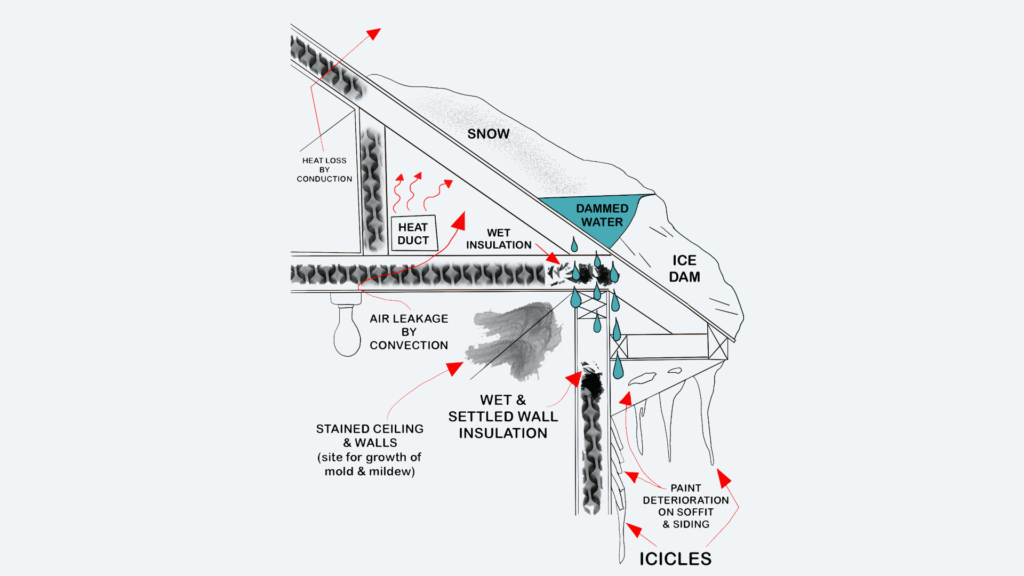What Is Ice Damming?
Winter brings with it a host of challenges for homeowners, from shoveling snow to ensuring the house remains warm. But there’s one winter phenomenon that often goes unnoticed until it causes significant damage: ice damming. If you’ve never heard of it or are unsure about its implications, you’re not alone. This article will delve into what ice damming is and why you might need a roofing expert to address it.
What is it?
An ice dam is a ridge of ice that forms at the edge of a roof, preventing melting snow from draining off the roof. The water that backs up behind this dam can leak into the home, causing damage to walls, ceilings, insulation, and other areas.

How Does Ice Damming Occur?
The process of ice damming typically involves a combination of snow cover, heat to melt the snow, and cold to refreeze the melted snow into solid ice. Here’s a step-by-step breakdown:
- Snow Accumulation: After a snowfall, a layer of snow accumulates on the roof.
- Heat Loss: The house loses heat, especially if the attic isn’t well-insulated. This heat warms the roof, causing the bottom layer of snow to melt.
- Melting and Refreezing: The melted snow flows down the roof slope until it reaches the colder eaves (the parts of the roof that overhang the walls). Here, away from the heat of the house, the water refreezes, forming an ice dam.
- Water Backup: As more snow melts and flows down, it gets trapped behind the ice dam. This water can then seep under shingles and find its way into the home.
Why is Ice Damming a Concern?
Ice damming poses several significant concerns, making it a serious issue that homeowners should address promptly. One of the primary worries is structural damage. When ice dams form and water seeps into the home, it can lead to damage in ceilings, walls, and insulation. Over time, this persistent moisture intrusion creates an environment conducive to mold growth. Mold not only causes structural deterioration but also poses health risks to occupants, potentially leading to respiratory problems and other health issues.
Roof damage is another critical concern associated with ice damming. As ice dams accumulate, they can lift roof shingles, creating pathways for water to infiltrate the roof structure. This not only results in immediate damage but can also significantly shorten the lifespan of the roof. The combination of water infiltration and freeze-thaw cycles can lead to compromised structural integrity and expensive repairs.
Additionally, ice dams can wreak havoc on gutters. The weight of the accumulated ice can pull gutters away from the house or cause damage to them, impacting their functionality. Damaged or detached gutters can exacerbate water runoff issues, leading to potential flooding and erosion around the foundation of the home.
Beyond property damage, ice damming also poses safety hazards. Large icicles forming from the edge of the roof can break off and fall, posing a threat to people below and potentially causing damage to property. Addressing ice dams promptly is not only essential for protecting the structural integrity of a home but also for ensuring the safety and well-being of its occupants.
Preventing Ice Damming
Preventing ice dams is crucial to maintaining the integrity of your roof and avoiding potential water damage to your home. One effective measure is to enhance attic insulation. A well-insulated attic acts as a barrier, preventing heat from escaping and minimizing the likelihood of snow melting on the roof. By reducing the heat transfer from the interior of your home to the roof, you create a more consistent temperature across the entire roof surface.
Proper attic ventilation is another key element in preventing ice dams. Adequate ventilation helps remove excess heat from the attic, maintaining a more even temperature on the roof. This prevents localized melting and refreezing, which can contribute to the formation of ice dams.
After heavy snowfall, utilizing a roof rake can be instrumental in preventing ice dams. By carefully removing accumulated snow from the edge of the roof, you reduce the chances of it melting and refreezing along the eaves, where ice dams commonly form.
To fortify your roof against water seepage, consider installing a water-repellent membrane beneath the roofing material. This additional layer acts as a barrier, preventing water from infiltrating the roof structure and contributing to the formation of ice dams.
Regular maintenance is essential in the prevention of ice dams. Ensure that gutters and downspouts are free of debris, allowing water to flow freely. Regular inspections and cleanings can help identify and address potential issues before they escalate, ultimately safeguarding your home from the damaging effects of ice dams.
How Can a Roofing Professional Help?
If you suspect you have an ice dam or want to prevent one, it’s essential to consult a roofing expert. Here’s why:
- Expert Assessment: A roofing professional can do a property evaluation and evaluate your roof’s condition, insulation, and ventilation to determine the risk factors for ice damming.
- Prevention: They can recommend and implement solutions like adding insulation, improving ventilation, or installing heating cables to prevent ice dams from forming.
- Safe Ice Dam Removal: If you already have an ice dam, a roofing expert can safely remove it without causing further damage to your roof.
Ice damming is more than just a winter annoyance; it’s a potential threat to the structural integrity and safety of your home. By understanding its causes and implications, homeowners can take proactive steps to prevent it. And when in doubt, it’s always best to consult a roofing professional. Their expertise can save you from costly repairs and ensure your home remains safe and dry throughout the winter months.
